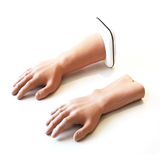Functional principle of Galileo Mechano-Stimulation Training©
 The principle of Galileo is based on the natural movement of human gait. Galileo’s side-alternating motion is similar to a seesaw movement with variable amplitude and frequency, and therefore stimulates a movement pattern similar to human gait. The rapid movement of the training platform causes a tilting movement of the pelvis, just like when walking, but much more frequently. To compensate, the body responds with rhythmic muscle contractions, alternating between the left and right side of the body. From a frequency of about 12 hertz onwards these muscle contractions are not a conscious process but, rather, are a reflex. This stretch reflex activates the muscles in the legs, the stomach and the back right up into the trunk.
The principle of Galileo is based on the natural movement of human gait. Galileo’s side-alternating motion is similar to a seesaw movement with variable amplitude and frequency, and therefore stimulates a movement pattern similar to human gait. The rapid movement of the training platform causes a tilting movement of the pelvis, just like when walking, but much more frequently. To compensate, the body responds with rhythmic muscle contractions, alternating between the left and right side of the body. From a frequency of about 12 hertz onwards these muscle contractions are not a conscious process but, rather, are a reflex. This stretch reflex activates the muscles in the legs, the stomach and the back right up into the trunk.
The number of stretch reflex contractions per second is determined by the adjustable training frequency. For example, if a training frequency of 25 hertz is selected, 25 cycles of contraction in flexor and extensor muscles occur per second.
A training session of 3 minutes at 25 hertz therefore causes the same number of muscle contractions as walking a distance of 4,500 steps.
The vibrations generated by Galileo can be continuously varied in amplitude and frequency independent of body weight.




-160x160-state_article-rel-cat.png)







-205x205.jpg)







